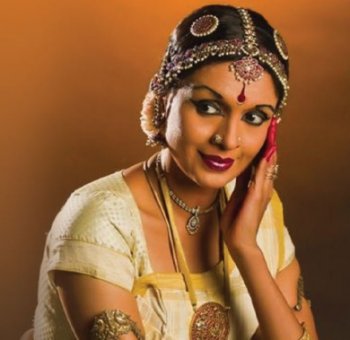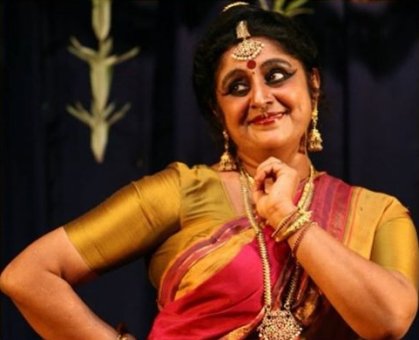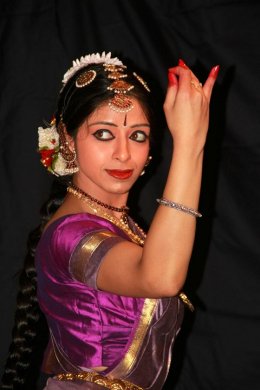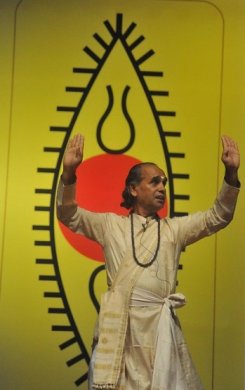
|   |

|   |
 e-mail: leelakaverivenkat@gmail.com Interactions and virtual Spic Macay Convention a unique experience - II June 19, 2020 Interactions and virtual Spic Macay Convention a unique experience - I Most dancers seem to combine the gift of silver tongued speakers. With guru- shishya being the main title of Spic Macay's Anubhav, Padma Subrahmanyam touched on many issues, including answering a question by a student on how mudra was different from Karanas! She spoke of her dance based on her Natya Sastra research as a 'revival with the Desi'. But one particularly appreciated her emphasis on the importance for dance aspirants of watching acclaimed dancers in action. As a junior, she mentioned just sitting in the class for hours as the seniors performed. Very important, considering how young dancers today want only to be seen on the stage performing and watching does not come easy for all. Rani Khanam mentioned how getting a good guru was as important for an aspiring dancer, as for the guru to get a good student. She too mentioned 'watching artistes perform' as a good method of learning. Having got trained in music first, she loved trying out off beat talas, and fast dancing. But the aesthetics of Kathak came home to her during her training at the Kathak Kendra under Pandit Birju Maharaj where the subtleties of 'Haath ka Andaaz', Kasak-masak, required hard abhyas, which is most essential. To carry a pot with (or without) water, or to portray ways of conveying messages delicately shifting the ghungat in subtle ways, come with a dancer's inner involvement, going beyond movement perfection. And for abhinaya (which she demonstrated through a short bhav batana presentation), making movement and the poetry communicative, the dancer's discerning ability is revealed even in a look (nazar andaz) which is not the same for a mother looking at her child, for Radha looking at Krishna, for a wife looking at the husband. Apart from her own solo expertise, Rani's work with the handicapped has earned her plaudits. "Don't separate handicapped from artiste," she pleaded. Priyadarsini Govind strongly believes in the transformative strength of art and today when Covid had thrown life in every field out of balance, art is what brings steadiness to her life. While respect for the Guru is a must, trust and patience are needed for the learning process offers no short cuts or instant gratification. Asked about her Kalakshetra period as Director, she pointed out that for this 'beautiful' institution, administrators had to be artistes with sensitivity for the task is challenging and not easy. Every experience, she maintained, provided an added dimension to the personality. Mentioning vatsalya as the sringar sentiment which attracts her most now, she however maintained that her 'dharma' as an artiste lay in fully communicating the sringar mood of the vaggayekara's lyric she uses as textual base for the dance. The abhinaya based performance part bore out the truth of her words for a major part of the abhinaya was based on the rati aspect of sringar - the first pertaining to a nayika experienced in the ways of love (text was based on Kshetrayya padam Kuvalayakshiro in Gaulipantu) scoffing at the other woman that the relationship she was now boasting about, would comprise only remnants of the deep passion the man concerned had shared with her earlier. The lilting vatsalya she depicted as Yashoda holding back Krishna from going to other homes and doing mischief was based on a semi classical lyric "Maadu meikkum kanne, nee poga vendaam sonnen."  Priyadarsini Govind  Chitra Visweswaran It was a prolonged interaction with Chitra Visweswaran about her days of training, and without saying so in actual words, the interesting details she mentioned underlined a significant aspect - that learning dance did not pertain to isolated learning of the technique and grammar of movement alone as much as representing a gradual process of absorption of a whole cultural ethos. As a youngster, she had alreadylearnt some Rabindra Nritya, Rabindra Sangeet, the type of dance taught in Santiniketan and much else before she came to Bharatanatyam. But her learning under one hailing from the traditional family T.A. Rajalakshmi who was trained under Tiruvidaimarudur Kuppiah Pillai, (son of Panchapakesha Nattuvanar in the royal court in Tanjore rendering services in the famous Brihadiswara temple), gradually over time, brought home to her the linkages of temple, court, music, literature and what have you. She spoke of the flavour of the times recapturing an incident to show how tradition is passed on, mentioning the background of a Jati she often uses, taught to her by T.A. Rajalakshmi - which was created on the spot by Kuppiah Pillai while Rajalakshmi was travelling with him in a bullock cart to a performance in the temple! When much later, Chitra came under Guru Vazhuvoor Ramiah Pillai, it was exposure to the emerging more innovative contemporary version of Bharatanatyam, after having experienced the temple tradition represented by her earlier Guru. When she joined Vazhuvoorar, there were two others with her in the class - not the multitude one faces today in Bharatanatyam classes. And about four performances in a year was normal those days. In-between was a great deal of introspection when one worked on understanding the intricacies of each item. Guru teaches the essentials. But the fillers come out of internalisation which is what is missing today. First discovering the dance in you and then finding yourself in the dance is a long journey of evolution which does not happen overnight. "You all have a lot of information today at the click of a button." But in internalising this language lies the strength. Unlike youngsters often made to in business like way go from one class to another following a cramped time table of myriad activities, in her days any class, whether Yoga or martial arts, was undertaken in full hearted participation - without thoughts of how it would help one - though everything one does adds something to the personality. Performances are not the end of learning and she mentioned that one can do other things too after learning dance. Saswati Sen in her interaction began with how she was inspired to take to dance by a dancer from Uruguay who is no more. She mainly spoke of her training under Pandit Birju Maharaj whose classes had shown her not just how to perfect the dance for performing but also how to teach and to create new work. Coming from Reba Vidyarthi's classes with a cosy familiarity, to the very different atmosphere under Maharaj-ji, was daunting. His ability to see the entire life around him in terms of rhythm and music, had taught her to sense both in every activity - natural and human. Thus while explaining to a foreigner a certain rhythmic phrase, framing that in explanations by linking it with some action in life, communicated the character of the rhythm at once. Bols with a light jump when described as the leaping of a deer for example, communicated to the learner at once. Amongst youngsters, I watched Apoorva Jayaraman, now training under Priyadarsini Govind, teaching on the internet. The way she explained the concept of hastas, and how each of them could be used to symbolise different concepts, and the manner in which she involved the youngsters in her workshop asking them to show other ways of using particular hastas, showed an excellent ability to communicate. She has the makings of a fine teacher. She is one amongst some young dancers seen across the country, who while respecting tradition want to connect it to a present, without destroying its core principles.  Apoorva Jayaraman  Ghanakanta Bora Borbayan Among the Gurus, it was interesting to listen to and watch Sattriya Guru Ghanakanta Bora Borbayan, whose upbringing and training in a Sattra entailed learning under Mahanta Maniram Dutta Muktiyar and later in Guwahati under Guru Raseswar Saikia Borbayan. Referring to the spiritual education (missing in today's world) which formed part of his upbringing, for him Art was a path leading to self realisation and divinity. Madhavadeva, Sankaradeva's prime disciple, spoke of the divine spark in all, which only needed awakening. Vaikuntha was not in after life but here, and for him performance was a sacred deed (Rukmini haram natakam - Mukti Sadakam). His demonstration comprising a prayer to the almighty through dance "Jaya Jaya Yadukula Kamala Pratapaka", was followed by a scene from Parijatapaharanam presented by his students led by Anwesa Mahanta. The entire presentation was a projection of devotion along with fine group discipline. Videos of our musical greats (too many to discuss fully) took the listener's mind away for a while from the disturbed situation the world is in with Covid19. N. Rajam, the Hindustani music violinist, gave wise counsel in the way to attract young minds to music. With three granddaughters who play wonderfully and can accompany her in concerts, she should know. The upbringing in a home should make music a part of growing up (even play through toy instruments) and life, and not something of a chore - till a stage is bound to come when the child begins to show special interest and then the formal classes can start. With her halo of white hair, the much venerated Prabha Atre reminiscing on her days of training and what she had acquired as boon from her Guru, supplemented by select parts of her old recordings played, made for some of the most treasured moments of the week. The Himalayan grandeur and sheer variety of her Yaman held me awestruck. She mentioned that for the longest time she had been taught just this one raga. "After this intense exercise, there was no raga I could not decipher in its depths." For her, alap meant bringing out the form and full aesthetic beauty of the raga. Bandishes she has composed fit it with this thinking. Delectable snatches of Madhuwanti, Maru Behag (which has had record sales), Kalawati showed her versatility. Her genius would seem to draw on inclusive inspiration as she herself said, from Carnatic music, and much else. The poetic emphasis for her was In a Thumri or Dadra. The Dadra in Pahadi "Kagare jareja, piyake mora le ja sandesha" had great emphasis on word and the bhav in the singing evoked the feel for both poetic content and music. "Music is a hard task master and calls for sacrifice. Being in service while trying to also practise music, is difficult," she said to the passionate young man, a great fan of hers, asking her questions. His passion for sangeet and interaction with Prabha Atre, in more ways than one, underlined the success of Spic Macay's mission in developing young Tansens (with an ear for music). Then there was that totally sur-perfect, brilliant raga Nanda in the meditative singing of Rajan - Sajan Misra (though while acknowledging the seniority, improvisatory magnificence not to speak of the Guru position of Rajan Misra, the performance space for Sajan Misra's interventions seemed limited). I appreciated Ashwini Bhide's remarks when she said that youngsters should derive anand (ecstasy) from listening to music. Intoning away about the spiritual connection, making it seem like some esoteric practice is not the method to attract youngsters to music. The pleasure of listening to good singing is what needs to be stressed. As one who completed her education, before taking to music as a full time occupation, one finds in her statements a mind which with all the grounding in tradition, is very contemporary. All the exchanges with artistes was by a carefully selected group of youngsters like Yashwant Parashar who through Spic Macay's programmes had acquired, over time, an understanding for the subject each was dealing with. For example, there was the young man talking to Dr. Karan Singh who spoke on the Vedas and Upanishad. Speaking about our great philosophical literature which raises fundamental questions on life and the Universe, he felt sorry that being unwisely labelled as too esoteric and religious, many youngsters are not aware of its contents. The young student in the exchange asked Dr. Karan Singh if he followed Adwaita, Dwaita or Visishtadwaita. The answer came pat, "Though I am a Shiva bhakt, Shankara's adwaita, which tries to accommodate dwaita at one level, is difficult to accept." He believed in Visishtadwaita. He was surprised that the youngster posing questions was obviously well informed. Altogether, the concert videos apart, Anubhav, with all its problems, gave food for thought and provided a unique experience.  Writing on the dance scene for the last forty years, Leela Venkataraman's incisive comments on performances of all dance forms, participation in dance discussions both in India and abroad, and as a regular contributor to Hindu Friday Review, journals like Sruti and Nartanam, makes her voice respected for its balanced critiquing. She is the author of several books like Indian Classical dance: Tradition in Transition, Classical Dance in India and Indian Classical dance: The Renaissance and Beyond. Post your comments Please provide your name and email id when you use the Anonymous profile in the blog to post a comment. All appropriate comments posted with name and email id in the blog will also be featured in the site. |